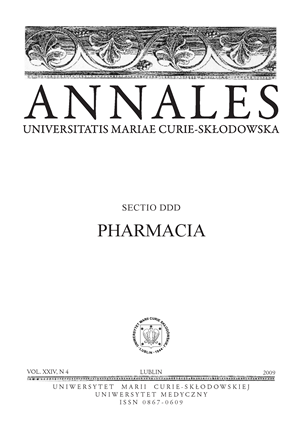Nanobiomodyfikacja nici szewnych za pomocą czynnika wzrostu śródbłonka naczyniowego(VEGF) – badania pilotażowe in vivo
Abstrakt
Opracowano metodę relatywnie stabilnego wiązania Czynnika Wzrostu Śródbłonka Naczyniowego (VEGF) do nici szewnych. Wpływ nanobiomodyfikowanej nici na proces leczenia przeszywanej ściany arterii został oceniony in vivo w modelu króliczym z użyciem technik histopatologicznych, immunohistochemicznych i elektronowego mikroskopu transmisyjnego. Rezultaty uzyskane z zastosowaniem mikroskopii transmisyjnej wykazały korzystny wpływ nici modyfikowanych VEGF na proces gojenia. Nici modyfikowane VEGF wzmogły proces gojenia, a zastosowane biomodyfikacje nie wywołały toksyczności biologicznej ani nietypowych zachowań tkanek w obrazie histologicznym.
Bibliografia
1. Barker S.G., Talber t A., Cottam S. et al.: Arterial intimal hyperplasia after occlusion of the adventitial vasa vasorum in the pig. Arterioscler. Thromb., 13(1), 70, 1993.
2. Bates D.O., Harper S. J.: Regulation of vascular permeability by vascular endothelial growth factors. Vascul. Pharmacol., 39 (4-5), 225, 2002.
3. Belcarz A., Ginalska G., Zalewska J. et al.: Covalent coating of hydroxyapatite by keratin stabilizes gentamicin release. J. Biomed. Mater. Res. Part B. Applied Biomaterials, 89B, 102, 2009.
4. Byrne A.M., Bouchier-Hayes D. J., Harmey J. H.: Angiogenic and cell survival functions of vascular endothelial growth factor (VEGF). J. Cell. Mol. Med., 9 (4), 777, 2005.
5. Drake C. J., Lit t le C. D.: Exogenous vascular endothelial growth factor induces malformed and hyperfused vassels during embryonic neovascularization. Proc. Natl. Acad. Sci. USA, 92, 7657, 1995.
6. Ferrara N.: The role of VEGF in the regulation of physiological and pathological angiogenesis. EXS, 94, 209, 2005.
7. Ginalska G., Osińska M., Uryniak A. et al.: Antibacterial activity of gentamicin-bonded gelatin-sealed polyethylene terephthalate vascular prostheses. Eur. J. Vasc. Endovasc. Surg., 29, 419, 2005.
8. Hamdan A. D., Aiello L. P., Misare B. D. et al.: Vascular endothelial growth factor expression in canine peripheral vein bypass grafts. J. Vasc. Surg., 26 (1), 79, 1997.
9. Infanger M., Shakibaei M., Kossmehl P. et al.: Intraluminal application of vascular endothelial growth factor enhances healing of microvascular anastomosis in a rat model. J. Vasc. Res., 42 (3), 202, 2005.
10. Lindner V., Reidy M. A.: Expression of VEGF receptors in arteries after endothelial injury and lack of increased endothelial regrowth in response to VEGF. Arterioscler. Thromb. Vasc. Biol., 16 (11), 1399, 1996.
11. Petersen W., Pufe T., Stärke Ch. et al.: The effect of locally applied vascular endothelial growth factor an meniscus healing: gross and histological findings., Arch. Orthop. Trauma. Surg., 127, 235, 2007.
12. Seipelt R.G., Backer C.L., Mavroudis C. et al.: Topical VEGF enhances healing of thoracic aortic anastomosis for coarctation in a rabbit model. Circulation, 108 Suppl. 1, II 150, 2003.
13. Zachary I.: Signaling mechanisms mediating vascular protective actions of vascular endothelial growth factor Am. J. Physiol. Cell. Physiol., 280 (6), C1375, 2001.
Pobrania
Opublikowane
Numer
Dział
Licencja
Prawa autorskie (c) 2009 Autorzy

Praca jest udostępniana na licencji Creative Commons Attribution-NonCommercial-NoDerivatives 3.0 Unported License.


